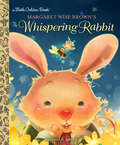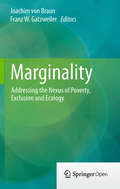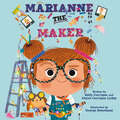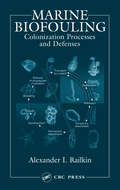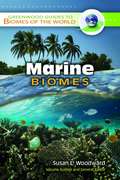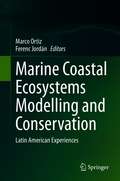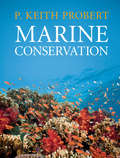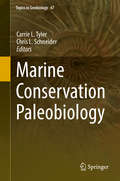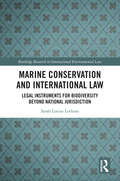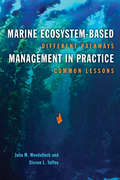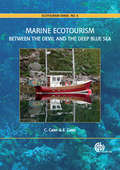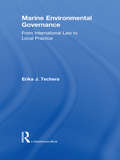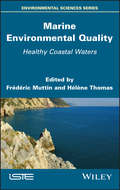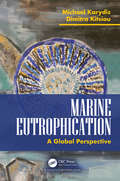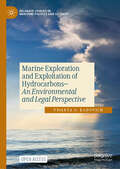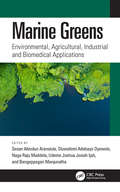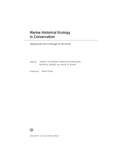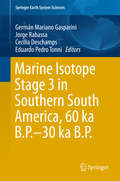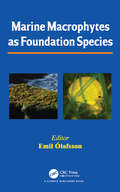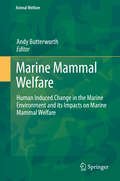- Table View
- List View
Margaret Wise Brown's The Whispering Rabbit (Little Golden Book)
by Margaret Wise BrownA bunny-rific bedtime story from the author of Goodnight Moon!Margaret Wise Brown's sweet, poetic tale about a little bunny and why he has to whisper was origininally published in the classic Golden Book The Golden Sleepy Book. Now newly illustrated in dreamy, seasonal pastels, this story is being reissued to delight the next generation of Little Golden Books fans.
Marginality: Addressing the Nexus of Poverty, Exclusion and Ecology
by Joachim Von Braun Franz GatzweilerThis book takes a new approach on understanding causes of extreme poverty and promising actions to address it. Its focus is on marginality being a root cause of poverty and deprivation. "Marginality" is the position of people on the edge, preventing their access to resources, freedom of choices, and the development of capabilities. The book is research based with original empirical analyses at local, national, and local scales; book contributors are leaders in their fields and have backgrounds in different disciplines. An important message of the book is that economic and ecological approaches and institutional innovations need to be integrated to overcome marginality. The book will be a valuable source for development scholars and students, actors that design public policies, and for social innovators in the private sector and non-governmental organizations.
Marianne the Maker
by Kelly Corrigan Claire Corrigan LichtyFrom bestselling author Kelly Corrigan and her daughter debut author Claire Corrigan Lichty comes a new picture book about a determined young inventor!Marianne's days are filled with schedules, structure, and soccer. There's just one problem: Marianne is a maker. She needs every minute of her weekends to scheme and dream, draw and design, to build and rebuild! This is the story of how a creator with a crackerjack imagination finds a not-so-great way to skip practice and create her masterpiece. But will her dad understand?Told in delightful rhyme that bounces across George Sweetland's gorgeous collage-style illustrations (chock full of hidden gems,) Marianne the Maker is sure to kindle the creative spark that lives inside all of us.
Marigolds, Myrtle and Moles: A Gardener's Bedside Book - the perfect book for gardening self-isolators
by Alan Titchmarsh'Charming miscellany of rhymes and reflections celebrating the garden'CHOICE***The perfect bedside book for the green-fingered - hilarious and touching poems on a gardening theme written and introduced by the nation's favourite gardener and presenter of ITV's Grow Your Own At Home and Love Your Garden, Channel 5's Secrets of the National Trust and with his own show on Classic FM.From touching poems on the peony, the snowdrop and the sweet pea to hilarious verse on Emily the Gardener and the Garden Design Course, this is Alan Titchmarsh's heartfelt and entertaining celebration of his favourite space - the garden.
Marigolds, Myrtle and Moles: A Gardener's Bedside Book - the perfect book for gardening self-isolators
by Alan Titchmarsh'Charming miscellany of rhymes and reflections celebrating the garden'CHOICE***The perfect bedside book for the green-fingered - hilarious and touching poems on a gardening theme written and introduced by the nation's favourite gardener and presenter of ITV's Grow Your Own At Home and Love Your Garden, Channel 5's Secrets of the National Trust and with his own show on Classic FM.From touching poems on the peony, the snowdrop and the sweet pea to hilarious verse on Emily the Gardener and the Garden Design Course, this is Alan Titchmarsh's heartfelt and entertaining celebration of his favourite space - the garden.
Marigolds, Myrtle and Moles: A Gardener's Bedside Book - the perfect book for gardening self-isolators
by Alan TitchmarshThe perfect listen for the green-fingered - hilarious and touching poems on a gardening theme written and introduced by the nation's favourite gardener and presenter of ITV's Love Your Garden, Channel 5's Secrets of the National Trust and with his own show on Classic FM.From touching poems on the peony, the snowdrop and the sweet pea to hilarious verse on Emily the Gardener and the Garden Design Course, this is Alan Titchmarsh's heartfelt and entertaining celebration of his favourite space - the garden.(P) 2020 Hodder & Stoughton Ltd
Marine Biofouling: Colonization Processes and Defenses
by Alexander I. RailkinRecent instances of bioinvasion, such as the emergence of the zebra mussel in the American Great Lakes, generated a demand among marine biologists and ecologists for groundbreaking new references that detail how organisms colonize hard substrates, and how to prevent damaging biomass concentrations.Marine Biofouling: Colonization Processes a
Marine Biomes (Greenwood Guides to Biomes of the World)
by Susan L. WoodwardThis book is arranged with an introductory section on marine biomes followed by chapters on coast, continental shelf, and deep sea biomes. Each of the chapters contains an overview of the biome on a global scale followed by selected regional examples. Woodward (retired, biogeography and physical geography, Radford U.) includes a glossary of terms and prefers to not use Latin names in the text, though she concludes each chapter with a concordance of English and Latin terminology. This publication can be used in tandem with other books on biomes in the series. Annotation ©2008 Book News, Inc., Portland, OR (booknews.com)
Marine Coastal Ecosystems Modelling and Conservation: Latin American Experiences
by Marco Ortiz Ferenc JordánThe book presents a collection of large-scale network-modeling studies on coastal systems in Latin America. It includes a novel description of the functioning of coastal complex ecosystems and also predicts how natural and human-made disturbances percolate through the networks. Coastal areas belong to the most populated ecosystems around the globe, and are massively influenced by human impacts such as shipping, mining, fisheries, tourism, pollution and human settlements. Even though many of these activities have facilitated socio-economic development, they have also caused a significant deterioration in natural populations, communities and ecosystems worldwide. Covering coastal marine ecosystems of Latin America such as the NE and SE Pacific, NW Atlantic and Caribbean areas, it discusses the construction of quantitative (Ecopath-Ecosim-Ecospace and Centrality of Node Sets) and semi-quantitative (Loop Analysis) multispecies trophic-network models to describe and assess the impacts of natural and human interventions like pelagic and benthic fishing as well as natural events such as El Niño, and La Niña. The book also features steady state (and/or near moving equilibrium) and dynamical models to support the management of exploited organisms, and applies and quantifies macroscopic indices, based on Ascendency (Ulanowicz) and Local Stability (Levins´ Loop Analysis). Further, it discusses the determination of the Keystone Species Complex Index, which is a holistic extension of the classical concept of Keystone Species (Paine), offering novel strategies for conservation monitoring and management.
Marine Conservation
by Probert P. KeithProviding a comprehensive account of marine conservation, this book examines human use and abuse of the world's seas and oceans and their marine life, and the various approaches to management and conservation. Healthy marine ecosystems - the goods and services that they provide - are of vital importance to human wellbeing. There is a pressing need for a global synthesis of marine conservation issues and approaches. This book covers conservation issues pertinent to major groups of marine organisms, such as sharks, marine turtles, seabirds and marine mammals; key habitats, from estuaries, wetlands and coral reefs to the deep sea; and from local and regional to international initiatives in marine conservation. An ideal resource for students, researchers and conservation professionals, the book pays appropriate attention to the underlying marine biology and oceanography and how human activities impact marine ecosystems, enabling the reader to fully understand the context of conservation action and its rationale.
Marine Conservation Paleobiology (Topics in Geobiology #47)
by Carrie L. Tyler Chris L. SchneiderThis volume describes and explores the emerging discipline of conservation paleobiology, and addresses challenges faced by established and young Conservation Paleobiologist's alike. In addition, this volume includes applied research highlighting how conservation paleobiology can be used to understand ecosystem response to perturbation in near and deep time. Across 10 chapters, the book aims to (1) explore the goals of conservation paleoecology as a science, (2) highlight how conservation paleoecology can be used to understand ecosystems’ responses to crises, (3) provide case studies of applications to modern ecosystems, (4) develop novel applications of paleontological approaches to neontological data, and (5) present a range of ecosystem response and recovery through environmental crises, from high-resolution impacts on organism interactions to the broadest scale of responses of the entire marine biosphere to global change. The volume will be of interest to paleoecologists, paleobiologists, and conservation biologists.
Marine Conservation and International Law: Legal Instruments for Biodiversity Beyond National Jurisdiction (Routledge Research in International Environmental Law)
by Sarah Louise LothianThis book provides a blueprint for an International Legally Binding Instrument (ILBI) for the conservation and sustainable use of marine biodiversity beyond national jurisdiction (BBNJ). The development of an ILBI could signify a pivotal turning point in the law of the sea by addressing regulatory, governance and institutional gaps and deficiencies in the existing international law framework for BBNJ. This book analyses the essential components an ILBI will require to effectively conserve and sustainably use BBNJ, focusing on marine genetic resources, areabased management tools, environmental impact assessments, capacity-building and marine technology transfer. It investigates potential areas of compromise, as the success of an ILBI will rely upon the support of a powerful bloc of maritime States, principally the United States, the United Kingdom, Russia, the Netherlands, France and Japan. The participation of major maritime powers will be critical as it is their nationals, corporations and flag vessels that have the financial and technical wherewithal to undertake activities beyond national jurisdiction. This bloc of States has historically been the strongest proponent of the Grotian doctrine of ‘freedom of the seas’ as it aligns with their predominant interest to preserve navigational freedom for their merchant and military fleets. Accordingly, this book assesses the extent to which the Grotian doctrine continues to exert influence on the development of the law of the sea and the development of an ILBI. Providing a comprehensive overview of this important development in international law, this book will be of interest to students, lecturers and academics of law of the sea, international environmental law and biodiversity law.
Marine Distributions (The Royal Society of Canada Special Publications #5)
by Maxwell DunbarA symposium of the Royal Society of Canada was held in June 1962 to outline what is being done in Canadian oceanography to map salinity, temperature, and plankton in the waters around Canada and in the North Atlantic across to Europe. This volume, based on the symposium, emphasizes the interdisciplinary nature of research in marine biogeography and in the distribution of environmental factors in the sea. The book is intended to show the breadth of biogeographic work in the sea, and the relation between biogeography and the physics and chemistry of the marine environment. It serves also to introduce to the scientific public the new Serial Atlas of the Marine Environment, a scientific journal of a new kind of sponsored jointly by the Royal Society of Canada and the U.S. National Academy of Sciences.
Marine Ecosystem-Based Management in Practice: Different Pathways, Common Lessons
by Julia M. Wondolleck Steven Lewis YaffeeWhat are the key ingredients of successful marine ecosystem planning? The surprising answer, according to authors Julia Wondolleck and Stephen Yaffee, is that a successful approach calls for more than just sound organizational structure and resources, but also a comfortable atmosphere of trust, understanding, and collaboration.Marine Ecosystem-Based Management in Practice is the first practical guide for the marine conservation realm. In a unique collection of case studies, the authors showcase successful collaborative approaches to ecosystem-based management. This book offers a hopeful message to policy makers, managers, practitioners, and students who will find this an indispensable guide to field-tested, replicable marine conservation management practices that work.
Marine Ecotourism: Between the Devil and the Deep Blue Sea
by Carl Cater Erlet CaterThis text examines the wide range of marine ecotourism resources, not only natural, but also cultural and man-made. This book also considers the vital role of marine ecotourism in raising awareness of the significance of the seas and oceans to sustainable coastal livelihoods. At a time of great concern over the effects of climate change and high profile issues such as depletion of fish stocks and oil spillages, the insights this book provides are essential reading.
Marine Environmental Governance: From International Law to Local Practice
by Erika TecheraMarine Environmental Governance: From International Law to Local Practice considers the relationship between international environmental law and community-based management of marine areas. Focusing on small island states, in which indigenous populations have to a large extent continued to maintain traditional lifestyles, this book takes up the question of how indigenous customary law and state-based legislation can be reconciled in the implementation of international environmental law. Including a range of case studies, as well as detailed comparative analysis, it pursues an interdisciplinary approach to legal pluralism 'in practice' that will be of considerable interest to environmental lawyers, legal anthropologists, conservation biologists and those working in the area of community-based conservation.
Marine Environmental Quality: Healthy Coastal Waters
by Frédéric Muttin Hélène ThomasUnderstanding marine pollution and the contamination of coastal environments requires knowledge from a variety of scientific fields. Marine Environmental Quality promotes a multidisciplinary approach to investigations, drawing on not only natural sciences, but also applied mathematics and social sciences.The investigations in this book focus on both organic and inorganic pollutants, firstly in a study conducted in the city of La Rochelle, on the North Atlantic French coast, then expanding the areas under examination to regions of English and Portuguese waters and, lastly, to the Mediterranean Sea. The improvement such research can bring to biomarkers, models and experiments enables equal progress in the quality of seawater in ports and protected areas of coastal regions.The eight chapters of Marine Environmental Quality present many aspects of this research, including experiments with floating barriers, water governance in various areas, sampling sites and sentinel species that act as biomarkers in harbors. Also covered are environmental commitments, both international and local, the risk that marine contamination poses to human health, experimental designs for interactions with microplastics and a study biomonitoring the juveniles of sentinel species. Such results will bring many benefits, to human health, to economic inclusion and to regional development.
Marine Eutrophication: A Global Perspective
by Michael Karydis Dimitra KitsiouMarine eutrophication has been recognized as a global problem with adverse effects on ecosystem’s health and the economies of coastal states. Most conventions regarding marine environmental protection of Regional Seas have given priority to eutrophication and relevant management practices. This book presents a global perspective of eutrophication in most of the Regional Seas, including the legal framework, assessment and management practices. Information on ecosystem’s impact as well as an outline of the methods used for assessing eutrophication is also provided. This volume will be useful to research students, marine scientists and policy makers working in marine environmental management. Key Features: Contributes to the understanding of the eutrophication processes and problems Presents an extensive account of the data analysis methods used for the quantitative assessment of eutrophication Looks the eutrophication status of the main regional seas Provides information on eutrophication politics and measures to mitigate eutrophication
Marine Exploration and Exploitation of Hydrocarbons: An Environmental and Legal Perspective (Palgrave Studies in Maritime Politics and Security)
by Violeta S. RadovichThe book analyzes the environmental regulation of upstream marine exploration and exploitation of hydrocarbons, at the international, regional MERCOSUR and Argentine national level. It uses the concept of normative integration as a methodological approach, critically assessing the interaction between the law of the sea, maritime law, environmental law and human rights law in the field of study. The book analyses the legal framework in a timeline, giving context to the evolution of the different branches of international law with sparkles of history. In this sense, the book also analyses international conventions’ bills on the subject that have not entered into force. The manuscript focuses on the reports from two marine pollution events (Deepwater Horizon and Montara oil spills) to analyse the lessons learnt and the normative and institutional framework needed to ensure environmental safety in the marine exploration and exploitation of hydrocarbons. The book critically analyses marine platform accidents’ official reports comprehensively in order to assess existing normative and institutional frameworks and to give a way forward regarding policies. The manuscript contributes to rethinking the governance of the ocean at the time of environmental challenges. In that context, it refers to the concept of normative integration and effectiveness. It takes the existing scholarship further by introducing the notion of “marine platforms” instead of “offshore platforms” to rethink the relationship between land and sea and to develop a functional approach to enhance existing regulations. This is an open access book.
Marine Greens: Environmental, Agricultural, Industrial and Biomedical Applications
by Sesan Abiodun Aransiola, Oluwafemi Adebayo Oyewole, Naga Raju Maddela, Udeme Joshua Josiah Ijah, and Bangeppagari ManjunathaThis book provides an in-depth overview of marine greens and their environmental and biotechnological applications. It addresses concepts such as the niche adaptation strategies of marine greens in their natural habitats, as well as their global distribution, and factors affecting their distribution and proliferation.Marine greens are posited as an alternative to fossil fuels, mitigating global climate change and thereby fostering future environmental sustainability. In addition, the book explains the remediation of xenobiotics, wastewater, microplastics, marine debris and marine green contamination. Expert authors from around the world explore the industrial and agricultural applications of marine greens in the production of enzymes and marine bioenergy, and what is needed to improve its production potential.This is important reading for government and non-governmental organizations as well as industries and research institutions looking for ways to combat current industrial and environmental challenges.
Marine Hard Bottom Communities
by Martin WahlMarine hard bottoms feature some of the most spectacular and diverse biological communities on this planet. These not only contain a rich treasure of genetic, taxonomic and functional information but also deliver irreplaceable ecosystem services. At the same time, they are highly vulnerable and increasingly threatened by anthropogenic pressures. This volume has collected contributions by 50 scientists from numerous biogeographic regions, dealing with characteristics of hard bottom communities. Distributional patterns in space and time are described, followed by analyses of the intrinsic and extrinsic dynamics producing these patterns. A strong emphasis is placed on the ongoing changes occurring in the structure and diversity of these communities in response to spiralling environmental impacts, and on state-of-the-art countermeasures aiming to preserve these ecological treasures. Finally, various values of diversity are assessed, hopefully as an incentive for enhanced conservation efforts.
Marine Historical Ecology in Conservation: Applying the Past to Manage for the Future
by John N. Kittinger Loren Mcclenachan Keryn B. Gedan Louise K. BlightThis pioneering volume provides a blueprint for managing the challenges of ocean conservation using marine historical ecology--an interdisciplinary area of study that is helping society to gain a more in-depth understanding of past human-environmental interactions in coastal and marine ecosystems and of the ecological and social outcomes associated with these interactions. Developed by groundbreaking practitioners in the field, Marine Historical Ecology in Conservation highlights the innovative ways that historical ecology can be applied to improve conservation and management efforts in the oceans. The book focuses on four key challenges that confront marine conservation: (1) recovering endangered species, (2) conserving fisheries, (3) restoring ecosystems, and (4) engaging the public. Chapters emphasize real-world conservation scenarios appropriate for students, faculty, researchers, and practitioners in marine science, conservation biology, natural resource management, paleoecology, and marine and coastal archaeology. By focusing on success stories and applied solutions, this volume delivers the required up-to-date science and tools needed for restoration and protection of ocean and coastal ecosystems.
Marine Isotope Stage 3 in Southern South America, 60 KA B.P.-30 KA B.P.
by Jorge Rabassa Germán Mariano Gasparini Eduardo Pedro Tonni Cecilia DeschampsThis book presents isotope data reflecting changes in temperature derived from core samples in South America. Marine Isotope Stage (MIS) is examined in detail with respect to Stage 3. With over 20 chapters, this detailed treatise discusses high climatic variability, paleoclimatic events, Dansgaard-Oeschger cycles, continental vertebrates, sea level changes, vegetation and climate changes based on pollen records, and the non-Amazon landscape and fauna from 65 to 20 ka B. P. The book also looks at the earth's magnetic field and climate change during MIS 3 and MIS 5 and presents a comparison between both stages with respect to marine deposits in Uruguay. With case studies drawn from Brazil, Argentina and Uruguay this book presents research from the some of the worlds experts in this field.
Marine Macrophytes as Foundation Species
by Emil OlafssonMarine macrophytes (macroalgae, seagrasses, and mangroves) comprise thousands of species distributed in shallow water areas along the world’s coastlines. They play a key role in marine ecosystems regarding biodiversity and energy flow. A large proportion of macrophyte species can be characterised as ecosystem engineers—organisms that directly or indirectly affect the availability of resources to other species by modifying, maintaining, and creating habitats. <P><P>This book is divided into three main themes: <li>Marine macroalgae and seagrasses as sources of biodiversity gives an overview of the diversity of the main organisms associated with macrophytes, and their functional role and interactions within their hosts. <li> Primary and secondary production of Macrophytes synthesizes research on food web structures derived from/or associated with, macrophytes and the transfer of macrophytic primary and secondary production from one ecosystem to another. <li> Threats to macrophytic ecosystem engineers addresses human-induced effects including eutrophication, physical destruction, invasive species, and global warming. <P><P>The book is among the first one to concentrate on the value of macrophytes for the well-being of marine habitats. The book is aimed at academics but may be useful for students, policy makers, and laymen alike.
Marine Mammal Welfare
by Andy ButterworthMarine mammals attract human interest – sometimes this interest is benign or positive – whale watching, conservation programmes for whales, seals, otters, and efforts to clear beaches of marine debris are seen as proactive steps to support these animals. However, there are many forces operating to affect adversely the lives of whales, seals, manatees, otters and polar bears – and this book explores how the welfare of marine mammals has been affected and how they have adapted, moved, responded and sometimes suffered as a result of the changing marine and human world around them. Marine mammal welfare addresses the welfare effects of marine debris, of human traffic in the oceans, of noise, of hunting, of whale watching and tourism, and of some of the less obvious impacts on marine mammals – on their social structures, on their behaviours and migration, and also of the effects on captivity for animals kept in zoos and aquaria. There is much to think and talk about – how marine mammals respond in a world dramatically influenced by man, how are their social structures affected and how is their welfare impacted?
